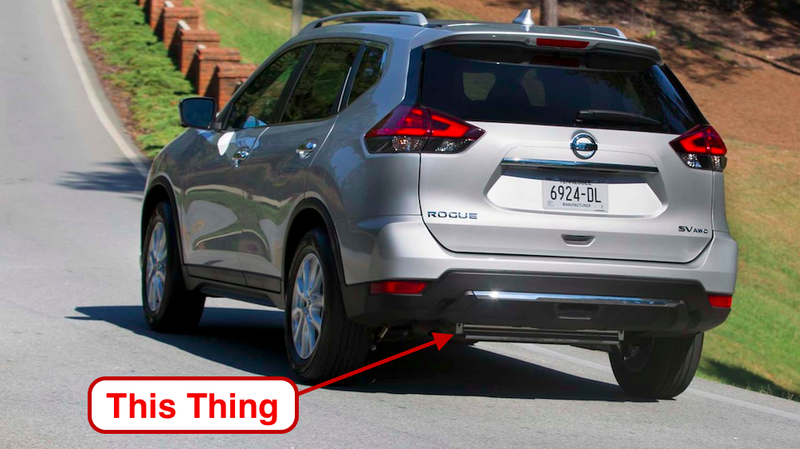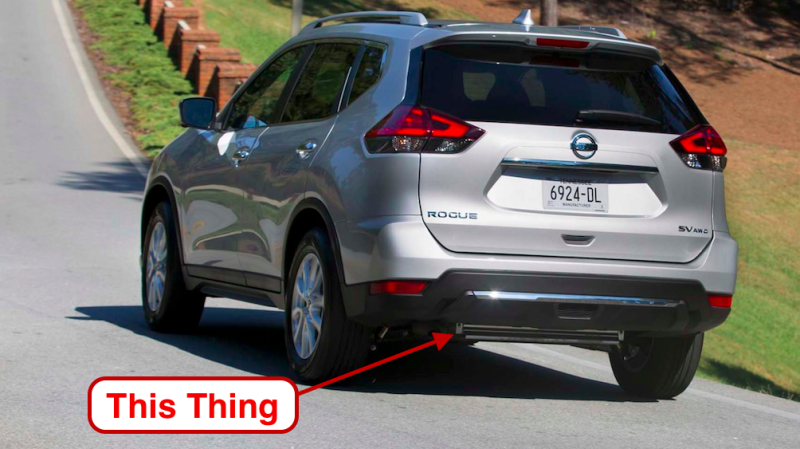
For years, Nissan Rogues across America have taunted me with what—from a distance—looks like a heat exchanger under their rear fascias. “What could this mystery heat-exchanger be?” I’ve spent many sleepless nights agonizing. Well, after finally looking at a Rogue up close, and talking with Nissan, I have the answer.
“Son of a bitch, I can’t take it any longer!” I cried last week after seeing another “heat exchanger” on the apparently Rogue-infested streets of suburban Detroit. It was time to stalk one of these crossovers, get up close, and find out once and for all what this heat-exchanger-looking thing was.
Lucky for me, the very moment I decided to do something about my longstanding “Rogue problem,” I looked up and saw one cruise right into a parking spot at Walmart. So, after the owner went in to buy dirt-cheap gear oil, SuperTech oil filters or whatever people buy from Walmart, I did what any normal person just like you would do: I hopped underneath a total stranger’s car.
That’s when I saw this:
Advertisement
“Whoa! This isn’t a heat exchanger at all!” I yelled at the top of my lungs, prompting a few folks to stare at me in bewilderment as I laid under some random person’s car. I was amazed that I’d gotten it so wrong for all these years.
Usually when I see sheetmetal surrounding hot exhaust components, I assume it’s there as a heat shield, in this case, perhaps to protect the plastic rear fascia. But looking at this component carefully, it was clear that this bit of metal was not there to protect plastic from thermal degradation.
Advertisement
For one, the metal only covered the very bottom rear part of the muffler; the area above it still had a nonzero radiation view factor; if this were a heat shield, it’d likely cover more of the rear of the muffler. It would also likely more closely follow the contours of the muffler (the muffler may actually just have a second “wall” built in), instead of having such a weird shape. More importantly, the fascia was fairly far away from the muffler, and muffler surface temps don’t tend to be that high. As such, I ruled out the heat shield thing.
Upon closer inspection, it became apparent that this shield—bolted to the muffler—served an aerodynamic purpose. In particular, I theorized, it was there to “detach” the flow from the airfoil-ish-shaped muffler, so that flow didn’t get trapped in the plastic rear fascia, which would act as a “parachute” and add drag (it’s worth noting that there also appears to be a vent in the rear fascia to reduce this effect).
Advertisement
Today, a Nissan representative confirmed my theory, though he would not divulge how many counts (drag coefficient thousandths) the formed piece of sheetmetal reduced. “That is a diffuser bolted onto the muffler,” he said. “The purpose of this diffuser is to push air downward so that air flowing underneath the muffler does not get trapped into the rear fascia.”
So there you have it; don’t be like me and this poor bastard on Reddit (and I’m sure dozens of others)and let the shadows between the bends of that sheetmetal confuse you into thinking there’s a heat exchanger on the back of the Nissan Rogue. There is not. It’s a diffuser, and it’s there to reduce drag by preventing air from flowing up into the rear fascia.
Advertisement
There, now we can all once again enjoy full nights of toss and turn-less sleep.













